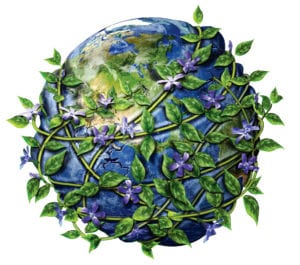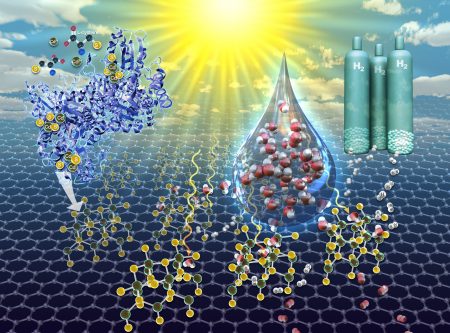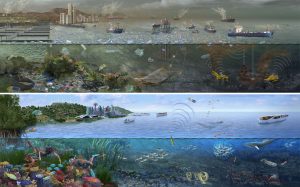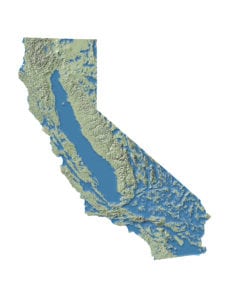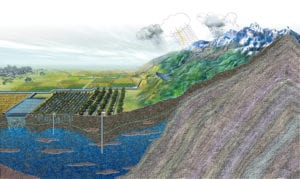
Happy Earth Day. We’ve collected 16 of our favorite Earth Day graphics that we’ve created over the years. Some of the illustrations are hand-drawn, some are computer generated with 3d software, but all highlight the work of scientists and organizations who strive to make the Earth a better place. Our science-art subject matter includes:
- invasive species art
- natural resource use illustrations
- solar and green energy graphics
- plastic pollution illustrations
- water conservation images
Invasive Plants Graphics
Vinca major is a beautiful garden plant that is often used in border plantings thanks to its no-effort growth. The problem with these resilient, non-native plants, is that they compete with and displace native species. Invasive plants can smother a landscape, leading to a monoculture threatening the biodiversity of the native ecosystem. We created this art for the non-profit group Sustainable Conservation.
Invasive, introduced, species harm native ecosystems. In a new habitat they often lack natural predators; compete with native species for resources in a shared niche; and threaten indigenous wildlife that have not evolved defenses against them. Invasive species also tend to grow and reproduce quickly, spreading aggressively. In California, pampas grass is planted as ornamental grass, but this weed can spread to the wild to compete with native vegetation—seedling trees, for instance—and poses a wildfire hazard due to the production of excessive dry foliage.
Gardeners can plant alternatives, like pink muhly instead of pampas grass. It’s similarly drought tolerant but is not invasive. It shares resources with neighboring plants and provides a habitat for birds and other wildlife. A shift to responsible home gardening practices can be promoted by partnering with home improvement stores where approximately 70% of U.S. plant sales are made. These invasive plant images are available for re-use here.
Natural Resource Use Graphics
Is increasing coal and natural gas extraction the answer to our energy crisis? The United States has ample supplies of natural gas (compared to petroleum), but drilling has environmental consequences and impacts on local communities. Often times oil, coal, gas mining and drilling takes place far from the eyes of the general public. As we assess costs and benefits, it’s essential that we all understand the ecological and community impacts of resource extraction. We illustrate unbiased depictions of these large-scale impacts for textbooks and science magazines.
We also help visualize the technology of engineers that are developing new ways to reduce pollution and seek alternatives. For example, carbon sequestration technology is a way to keep this harmful greenhouse gas out of the atmosphere.
Solar and Green Energy Alternatives Illustrations
Scientists look to nature to develop new, exciting ways to fuel our energy needs. National Science Foundation researchers have developed a thin layer of dye to absorb and transfer the energy of the sun more efficiently than current solar technology. Another exciting alternative energy harnesses algae growth to produce biofuel. As the biological machine harnesses the sun’s energy, it also repurposes pollution. And finally, Lehigh engineer Dr. Steven McIntosh is developing batteries powered by the sun, and a bacterial enzyme that can split hydrogen from water to prime fuel cells.
Earth Plastic Pollution Graphics
Picture our oceans in 30 years. What do you see? Our “Oceans in 2050” shows 2 starkly different visions: plastic/air pollution, collapsed fisheries, deep-sea oil drilling/mining; vs. healthy marine ecosystems thriving along-side clean energy, sustainable aquaculture, and responsible shipping. Created for Doug J. McCauley. You can read more in our article on Visualizing Plastic Pollution, or in our case study on creating the Oceans in 2050 art.
Water Conservation Graphics
California has an extensive groundwater network. During droughts, these underground reservoirs are of particular importance. However, these reserves are shrinking, and it’s essential to develop strategies to smartly use and replenish groundwater sources.
Only 1% of Earth’s freshwater is accessible from surface sources, such as lakes and rivers. Sixty-nine percent of the Earth’s freshwater is locked in ice, and the remaining 30% of freshwater is groundwater providing a critical “savings account” for dry years. However, these reserves are shrinking. It’s essential to develop strategies to smartly use and replenish groundwater sources. Dashed cloud outlines show predicted precipitation changes as the Earth’s climate warms.
Finally, engineers are studying more efficient ways to conserve water. From re-using ‘grey water,’ to reducing use in manufacturing and agriculture, to desalination plants for plentiful fresh water.


